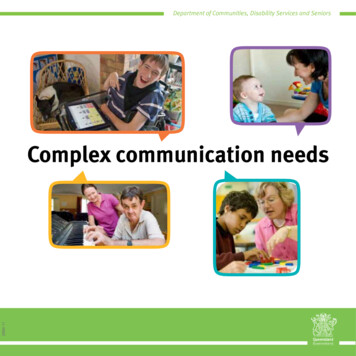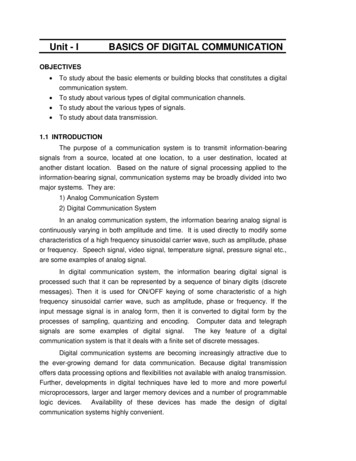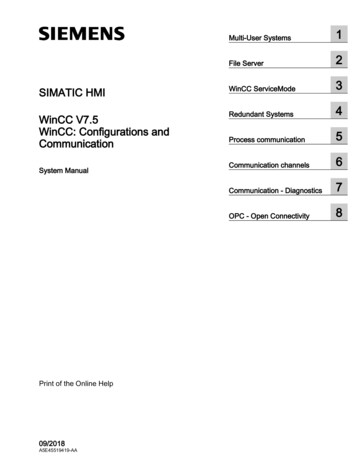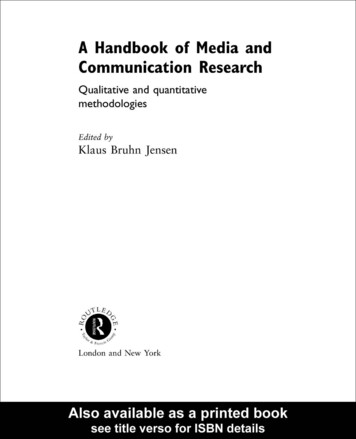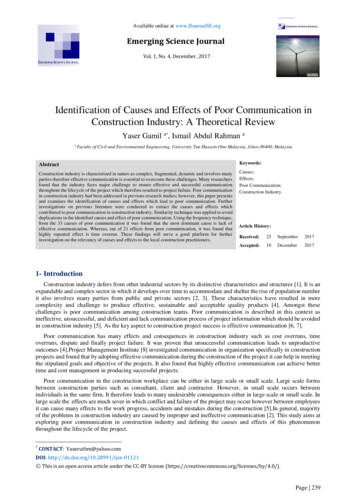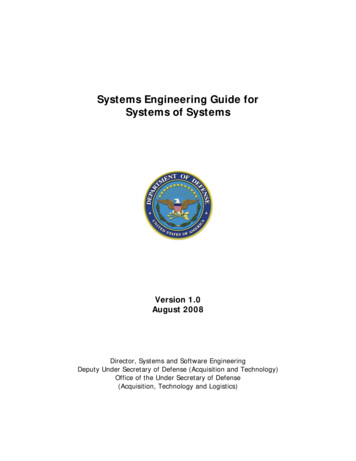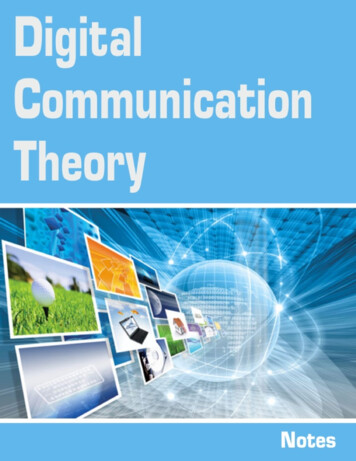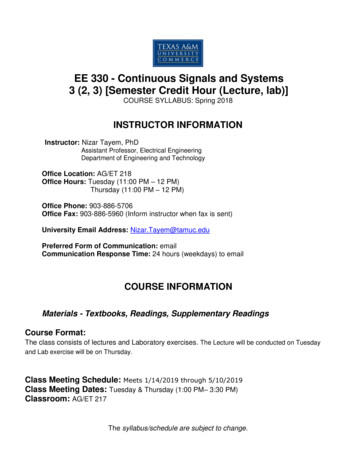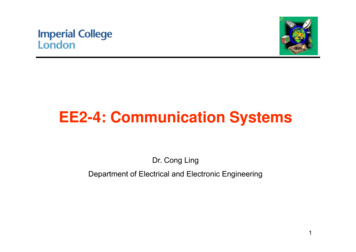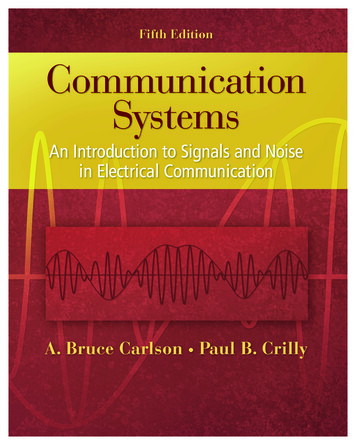
Transcription
car80407 fm i-xx.qxd9/1/098:59 AMPage iCOMMUNICATION SYSTEMSAn Introduction to Signals and Noisein Electrical CommunicationFIFTH EDITIONA. Bruce CarlsonLate of Rensselaer Polytechnic InstitutePaul B. CrillyUniversity of Tennessee
car80407 fm i-xx.qxd9/1/098:59 AMPage iiCOMMUNICATION SYSTEMS: AN INTRODUCTION TO SIGNALS AND NOISE IN ELECTRICALCOMMUNICATION, FIFTH EDITIONPublished by McGraw-Hill, a business unit of The McGraw-Hill Companies, Inc., 1221 Avenue of theAmericas, New York, NY 10020. Copyright 2010 by The McGraw-Hill Companies, Inc. All rightsreserved. Previous editions 2002, 1986, and 1975. No part of this publication may be reproduced ordistributed in any form or by any means, or stored in a database or retrieval system, without the priorwritten consent of The McGraw-Hill Companies, Inc., including, but not limited to, in any network orother electronic storage or transmission, or broadcast for distance learning.Some ancillaries, including electronic and print components, may not be available to customers outside theUnited States.This book is printed on acid-free paper.1 2 3 4 5 6 7 8 9 0 DOC/DOC 0 9ISBN 978–0–07–338040–7MHID 0–07–338040–7Global Publisher: Raghothaman SrinivasanDirector of Development: Kristine TibbettsDevelopmental Editor: Lora NeyensSenior Marketing Manager: Curt ReynoldsProject Manager: Melissa M. LeickSenior Production Supervisor: Sherry L. KaneSenior Media Project Manager: Jodi K. BanowetzAssociate Design Coordinator: Brenda A. RolwesCover Designer: Studio Montage, St. Louis, MissouriCompositor: Laserwords Private LimitedTypeface: 10/12 Times RomanPrinter: R. R. Donnelley Crawfordsville, INAll credits appearing on page or at the end of the book are considered to be an extension of thecopyright page.Library of Congress Cataloging-in-Publication DataCarlson, A. Bruce, 1937–Communication systems : an introduction to signals and noise in electrical communication /A. Bruce Carlson, Paul B. Crilly.—5th ed.p. cm.Includes index.ISBN 978–0–07–338040–7—ISBN 0–07–338040–7 (hard copy : alk. paper) 1. Signal theory(Telecommunication) 2. Modulation (Electronics) 3. Digital communications. I. Crilly, Paul B. II. Title.TK5102.5.C3 2010621.382 ' 23—dc222008049008www.mhhe.com
car80407 fm i-xx.qxd9/1/098:59 AMPage iiiTo my wife and best friend,Alice Kathleen Eiland CrillyTo my parents,Lois Brown Crilly and Ira Benjamin CrillyTo my grandmother,Harriet Wilson Crilly
car80407 fm i-xx.qxd 1/15/09 4:14 PM Page ivRev.Confirming PagesContentsThe numbers in parentheses after section titles identify previous sections that contain the minimum prerequisitematerial.Frequency Translation and Modulation 58Differentiation and Integration 60Chapter 1Introduction 11.12.4Elements and Limitationsof Communication Systems 2Convolution Integral 63Convolution Theorems 65Information, Messages, and Signals 2Elements of a Communication System 3Fundamental Limitations 51.2Modulation and Coding2.52.6Electromagnetic Wave Propagation OverWireless Channels 12Chapter 3Emerging Developments 17Societal Impact and HistoricalPerspective 20Signal Transmission and Filtering 913.1Prospectus 24Chapter 2Signals and Spectra 272.13.2Line Spectra and Fourier Series 293.3Transmission Loss and Decibels (3.2) 116Power Gain 116Transmission Loss and Repeaters 118Fiber Optics 119Radio Transmission 122Fourier Transforms and Continuous Spectra(2.1) 43Fourier Transforms 43Symmetric and Causal Signals 47Rayleigh’s Energy Theorem 50Duality Theorem 52Transform Calculations 542.3Signal Distortion in Transmission(3.1) 105Distortionless Transmission 105Linear Distortion 107Equalization 110Nonlinear Distortion and Companding 113Phasors and Line Spectra 29Periodic Signals and Average Power 33Fourier Series 35Convergence Conditions and GibbsPhenomenon 39Parseval’s Power Theorem 422.2Response of LTI Systems (2.4) 92Impulse Response and the SuperpositionIntegral 93Transfer Functions and FrequencyResponse 96Block-Diagram Analysis 102Historical Perspective 211.6Discrete Time Signals and the DiscreteFourier Transform 80Convolution Using the DFT (2.4) 83RF Wave Deflection 14Skywave Propagation 141.41.5Impulses and Transformsin the Limit (2.4) 68Properties of the Unit Impulse 68Impulses in Frequency 71Step and Signum Functions 74Impulses in Time 766Modulation Methods 6Modulation Benefits and Applications 8Coding Methods and Benefits 111.3Convolution (2.3) 623.4Filters and Filtering (3.3) 126Ideal Filters 126Bandlimiting and Timelimiting 128Real Filters 129Pulse Response and Risetime 134Time and Frequency Relations (2.2) 543.5Superposition 55Time Delay and Scale Change 55ivQuadrature Filters and HilbertTransforms (3.4) 138
car80407 fm i-xx.qxd 1/15/09 4:14 PM Page vRev.Confirming PagesContents3.6Correlation and Spectral Density (3.4) 141Correlation of Power Signals 141Correlation of Energy Signals 145Spectral Density Functions 147Phase Modulators and Indirect FM 234Triangular-Wave FM 237Frequency Detection 2395.4Linear CW Modulation 161Bandpass Signals and Systems (3.4) 162Analog Message Conventions 162Bandpass Signals 164Bandpass Transmission 168Bandwidth 1724.24.3Chapter 6Sampling and Pulse Modulation 2576.1Double-Sideband AmplitudeModulation (4.1) 173AM Signals and Spectra 173DSB Signals and Spectra 176Tone Modulation and Phasor Analysis 1786.2Pulse-Amplitude Modulation (6.1) 272Modulators and Transmitters (4.2) 1796.3Pulse-Time Modulation (6.2) 275Suppressed-Sideband AmplitudeModulation (3.5, 4.3) 185SSB Signals and Spectra 185SSB Generation 188VSB Signals and Spectra 1914.5Flat-Top Sampling and PAM 272Pulse-Duration and Pulse-PositionModulation 275PPM Spectral Analysis 278Chapter 7Analog Communication Systems 2877.1Frequency Conversion andDemodulation (4.4) 193Chapter 57.25.2Phase and Frequency Modulation(4.3) 2085.37.3Generation and Detection of FM andPM (4.5, 5.2) 232Direct FM and VCOs 233Phase-Locked Loops (7.1) 311PLL Operation and Lock-In 311Synchronous Detection and FrequencySynthesizers 314Linearized PLL Models and FMDetection 317Transmission Bandwidth andDistortion (5.1) 223Transmission Bandwidth Estimates 223Linear Distortion 226Nonlinear Distortion and Limiters 229Multiplexing Systems (4.5, 6.1) 297Frequency-Division Multiplexing 297Quadrature-Carrier Multiplexing 302Time-Division Multiplexing 303Crosstalk and Guard Times 307Comparison of TDM and FDM 309Angle CW Modulation 207PM and FM Signals 208Narrowband PM and FM 212Tone Modulation 213Multitone and Periodic Modulation 220Receivers for CW Modulation(2.6, 4.5, 5.3) 288Superheterodyne Receivers 288Direct Conversion Receivers 292Special-Purpose Receivers 293Receiver Specifications 294Scanning Spectrum Analyzers 295Frequency Conversion 194Synchronous Detection 195Envelope Detection 1985.1Sampling Theory and Practice(2.6, 4.2) 258Chopper Sampling 258Ideal Sampling and Reconstruction 263Practical Sampling and Aliasing 266Product Modulators 180Square-Law and Balanced Modulators 180Switching Modulators 1844.4Interference (5.3) 243Interfering Sinusoids 243Deemphasis and Preemphasis Filtering 245FM Capture Effect 247Chapter 44.1v7.4Television Systems (7.1) 319Video Signals, Resolution, and Bandwidth 319Monochrome Transmitters and Receivers 324Color Television 327HDTV 332
car80407 fm i-xx.qxd1/16/09vi9:43 AMPage viContentsChapter 8Probability and Random Variables 3458.18.2Probability and Sample Space 346Noise in Analog ModulationSystems 439Statistical Averages (2.3, 8.2) 365Probability Models (8.3) 371Chapter 9Random Signals and Noise 391Random Processes (3.6, 8.4) 392Ensemble Averages and CorrelationFunctions 393Ergodic and Stationary Processes 397Gaussian Processes 4029.29.310.1 Bandpass Noise (4.4, 9.2) 440System Models 441Quadrature Components 443Envelope and Phase 445Correlation Functions 44610.2 Linear CW Modulation WithNoise (10.2) 448Synchronous Detection 449Envelope Detection and Threshold Effect 45110.3 Angle CW Modulation With Noise(5.3, 10.2) 454Postdetection Noise 454Destination S/N 458FM Threshold Effect 460Threshold Extension by FM FeedbackDetection 46310.4 Comparison of CW Modulation Systems(9.4, 10.3) 46410.5 Phase-Locked Loop Noise Performance(7.3, 10.1) 46710.6 Analog Pulse Modulation With Noise(6.3, 9.5) 468Signal-to-Noise Ratios 468False-Pulse Threshold Effect 471Random Signals (9.1) 403Chapter 11Power Spectrum 403Superposition and Modulation 408Filtered Random Signals 409Baseband Digital Transmission 479Noise (9.2) 412Thermal Noise and Available Power 413White Noise and Filtered Noise 416Noise Equivalent Bandwidth 419System Measurements Using White Noise 4219.4Pulse Measurements in Noise 427Pulse Detection and MatchedFilters 429Chapter 10Binomial Distribution 371Poisson Distribution 373Gaussian PDF 374Rayleigh PDF 376Bivariate Gaussian Distribution 378Central Limit Theorem 3799.1Baseband Pulse Transmission WithNoise (9.4) 427Random Variables and ProbabilityFunctions (8.1) 354Means, Moments, and Expectation 365Standard Deviation and Chebyshev’sInequality 366Multivariate Expectations 368Characteristic Functions 3708.49.5Probabilities and Events 346Sample Space and Probability Theory 347Conditional Probability and StatisticalIndependence 351Discrete Random Variables and CDFs 355Continuous Random Variables and PDFs 358Transformations of Random Variables 361Joint and Conditional PDFs 3638.3Rev.Confirming PagesBaseband Signal Transmission WithNoise (9.3) 422Additive Noise and Signal-to-Noise Ratios 422Analog Signal Transmission 42411.1 Digital Signals and Systems (9.1) 481Digital PAM Signals 481Transmission Limitations 484Power Spectra of Digital PAM 487Spectral Shaping by Precoding 49011.2 Noise and Errors (9.4, 11.1) 491Binary Error Probabilities 492Regenerative Repeaters 496Matched Filtering 498Correlation Detector 501M-ary Error Probabilities 502
car80407 fm i-xx.qxd 1/15/09 4:14 PM Page viiRev.Confirming PagesContents11.3 Bandlimited Digital PAMSystems (11.2) 50613.2 Linear Block Codes (13.1) 604Matrix Representation of Block Codes 604Syndrome Decoding 608Cyclic Codes 611M-ary Codes 616Nyquist Pulse Shaping 506Optimum Terminal Filters 509Equalization 513Correlative Coding 51713.3 Convolutional Codes (13.2) 61711.4 Synchronization Techniques (11.2) 523Bit Synchronization 524Scramblers and PN Sequence Generators 526Frame Synchronization 531Convolutional Encoding 617Free Distance and Coding Gain 623Decoding Methods 629Turbo Codes 635Chapter 14Chapter 12Digitization Techniques for AnalogMessages and ComputerNetworks 54312.1 Pulse-Code Modulation (6.2, 11.1) 544PCM Generation and Reconstruction 545Quantization Noise 548Nonuniform Quantizing and Companding 55012.2 PCM With Noise (11.2, 12.1) 554Decoding Noise 555Error Threshold 557PCM Versus Analog Modulation 557Bandpass Digital Transmission 64714.1 Digital CW Modulation(4.5, 5.1, 11.1) 648Spectral Analysis of Bandpass DigitalSignals 649Amplitude Modulation Methods 650Phase Modulation Methods 653Frequency Modulation Methods 655Minimum-Shift Keying (MSK) andGaussian-Filtered MSK 65814.2 Coherent Binary Systems(11.2, 14.1) 663Optimum Binary Detection 663Coherent OOK, BPSK, and FSK 668Timing and Synchronization 670Interference 67112.3 Delta Modulation and PredictiveCoding (12.2) 559Delta Modulation 560Delta-Sigma Modulation 565Adaptive Delta Modulation 566Differential PCM 567LPC Speech Synthesis 56914.3 Noncoherent Binary Systems(14.2) 67312.4 Digital Audio Recording (12.3) 571CD Recording 571CD Playback 57412.5 Digital Multiplexing (12.1, 9.2)vii575Multiplexers and Hierarchies 575Digital Subscriber Lines 579Synchronous Optical Network 580Data Multiplexers 582Chapter 13Channel Coding 59113.1 Error Detection and Correction (11.2) 592Repetition and Parity-Check Codes 592Interleaving 595Code Vectors and Hamming Distance 595Forward Error-Correction (FEC) Systems 597ARQ Systems 600Envelope of a Sinusoid Plus BandpassNoise 673Noncoherent OOK 674Noncoherent FSK 677Differentially Coherent PSK 67914.4 Quadrature-Carrier and M-arySystems (14.2) 682Quadrature-Carrier Systems 682M-ary PSK Systems 685M-ary QAM Systems 689M-ary FSK Systems 690Comparison of Digital ModulationSystems 69214.5 Orthogonal Frequency Division Multiplexing(OFDM) (14.4, 7.2, 2.6) 696Generating OFDM Using the Inverse DiscreteFourier Transform 697Channel Response and Cyclic Extensions 700
car80407 fm i-xx.qxd 1/15/09 4:14 PM Page viiiviiiRev.Confirming PagesContents14.6 Trellis-Coded Modulation (13.3, 14.4) 703TCM Basics 704Hard Versus Soft Decisions 712Modems 712Chapter 15Spread-Spectrum Systems 72115.1 Direct-Sequence Spread-Spectrum(14.2) 723DSSS Signals 723DSSS Performance in Presence ofInterference 726Multiple Access 728Multipath and the Rake Receiver 72915.2 Frequency-Hopping Spread-Spectrum(15.1) 733FHSS Signals 733FHSS Performance in the Presence ofInterference 735Other SS Systems 73715.3 Coding (15.1, 11.4) 73815.4 Synchronization (7.3) 743Acquisition 743Tracking 74515.5 Wireless Systems (15.2, 3.3, 14.5) 746Telephone Systems 746Wireless Networks 75115.6 Ultra-Wideband Systems (6.3, 15.1) 754UWB Signals 754Coding Techniques 756Transmit-Reference System 758Multiple Access 759Comparison With Direct-Sequence SpreadSpectrum 760Chapter 16Information and DetectionTheory 76716.2 Information Transmission on DiscreteChannels (16.1) 782Mutual Information 782Discrete Channel Capacity 786Coding for the Binary SymmetricChannel 78816.3 Continuous Channels and SystemComparisons (16.2) 791Continuous Information 791Continuous Channel Capacity 794Ideal Communication Systems 796System Comparisons 79916.4 Signal Space 803Signals as Vectors 803The Gram-Schmidt Procedure 80616.5 Optimum Digital Detection(16.3, 16.4) 808Optimum Detection and MAP Receivers 809Error Probabilities 815Signal Selection and OrthogonalSignaling 818Appendix: Circuit and SystemNoise (9.4) 827Circuit and Device Noise 828Amplifier Noise 835System Noise Calculations 840Cable Repeater Systems 844Tables 847T.1T.2T.3T.4T.5T.6T.7Fourier Transforms 847Fourier Series 849Mathematical Relations 851The Sinc Function 854Probability Functions 855Gaussian Probabilities 857Glossary of Notation 85916.1 Information Measure and SourceEncoding (12.1) 769Information Measure 769Entropy and Information Rate 771Coding for a Discrete Memoryless Channel 774Predictive Coding for Sources With Memory 778Solutions to Exercises 861Answers to Selected Problems 904Index 911
car80407 fm i-xx.qxd9/1/098:59 AMPage ixPrefaceThis text, like its previous four editions, is an introduction to communication systems written at a level appropriate for advanced undergraduates and first-year graduate students in electrical or computer engineering.An initial study of signal transmission and the inherent limitations of physicalsystems establishes unifying concepts of communication. Attention is then given toanalog communication systems, random signals and noise, digital systems, andinformation theory.Mathematical techniques and models necessarily play an important rolethroughout the book, but always in the engineering context as means to an end.Numerous applications have been incorporated for their practical significance and asillustrations of concepts and design strategies. Some hardware considerations arealso included to justify various communication methods, to stimulate interest, and tobring out connections with other branches of the field.PREREQUISITE BACKGROUNDThe assumed background is equivalent to the first two or three years of an electricalor computer engineering curriculum. Essential prerequisites are differential equations, steady-state and transient circuit analysis, and a first course in electronics. Students should also have some familiarity with operational amplifiers, digital logic,and matrix notation. Helpful but not required are prior exposure to linear systemsanalysis, Fourier transforms, and probability theory.CONTENTS AND ORGANIZATIONNew features of this fifth edition include (a) the addition of MATLAB† examples,exercises and problems that are available on the book’s website, www.mhhe.com/carlsoncrilly; (b) new end-of-chapter conceptual questions to reinforce the theory,provide practical application to what has been covered, and add to the students’problem-solving skills; (c) expanded coverage of wireless communications and anintroduction to radio wave propagation that enables the reader to better appreciate thechallenges of wireless systems; (d) expanded coverage of digital modulation systemssuch as the addition of orthogonal frequency division modulation and ultra widebandsystems; (e) expanded coverage of spread spectrum; (f) a discussion of wireless networks; and (g) an easy-to-reference list of abbreviations and mathematical symbols.Following an updated introductory chapter, this text has two chapters dealingwith basic tools. These tools are then applied in the next four chapters to analog communication systems, including sampling and pulse modulation. Probability, randomsignals, and noise are introduced in the following three chapters and applied to analogsystems. An appendix separately covers circuit and system noise. The remaining†MATLAB is a registered trademark of MathWorks Inc.ix
car80407 fm i-xx.qxdx9/1/098:59 AMPage xPrefacesix chapters are devoted to digital communication and information theory, whichrequire some knowledge of random signals and include coded pulse modulation.All sixteen chapters can be presented in a yearlong undergraduate course withminimum prerequisites. Or a one-term undergraduate course on analog communication might consist of material in the first seven chapters. If linear systems and probability theory are covered in prerequisite courses, then most of the last eight chapterscan be included in a one-term senior/graduate course devoted primarily to digitalcommunication.The modular chapter structure allows considerable latitude for other formats.As a guide to topic selection, the table of contents indicates the minimum prerequisites for each chapter section.INSTRUCTIONAL AIDSEach chapter after the first one includes a list of instructional objectives to guide student study. Subsequent chapters also contain several examples and exercises. Theexercises are designed to help students master their grasp of new material presentedin the text, and exercise solutions are given at the back. The examples have been chosen to illuminate concepts and techniques that students often find troublesome.Problems at the ends of chapters are numbered by text section. They range frombasic manipulations and computations to more advanced analysis and design tasks.A manual of problem solutions is available to instructors from the publisher.Several typographical devices have been incorporated to serve as aids forstudents. Specifically, Technical terms are printed in boldface type when they first appear.Important concepts and theorems that do not involve equations are printedinside boxes.Asterisks (*) after problem numbers indicate that answers are provided at theback of the book.The symbol ‡ identifies the more challenging problems.Tables at the back of the book include transform pairs, mathematical relations,and probability functions for convenient reference.Communication system engineers use many abbreviations, so in addition to theindex, there is a section that lists common abbreviations. Also included is a list of themore commonly used mathematical symbols.Online ResourcesThe website that accompanies this text can be found at www.mhhe.com/carlsoncrillyand features new MATLAB problems as well as material on computer networks(TCP/IP) and data encryption. The website also includes an annotated bibliographyin the form of a supplementary reading list and the list of references. The complete
car80407 fm i-xx.qxd 1/15/09 4:14 PM Page xiRev.Confirming PagesPrefacesolutions manual, PowerPoint lecture notes, and image library are available onlinefor instructors. Contact your sales representative for additional information on thewebsite.Electronic Textbook OptionsThis text is offered through CourseSmart for both instructors and students. CourseSmart is an online resource where students can purchase the complete text online atalmost half the cost of a traditional text. Purchasing the eTextbook allows students totake advantage of CourseSmart’s web tools for learning, which include full textsearch, notes and highlighting, and email tools for sharing notes between classmates.To learn more about CourseSmart options, contact your sales representative or visitwww.CourseSmart.com.ACKNOWLEDGMENTSI am indebted to the many people who contributed to previous editions. I want tothank Professors Marshall Pace, Seddick Djouadi, and Aly Fathy for their feedbackand the use of their libraries; the University of Tennessee Electrical Engineering andComputer Science Department for support; Ms. Judy Evans, Ms. Dana Bryson,Messrs. Robert Armistead, Jerry Davis, Matthew Smith, and Tobias Mueller for theirassistance in manuscript preparation.Thanks, too, for the wonderful feedback from our reviewers: Ali Abdi, NewJersey Institute of Technology; Venkatachalam Anantharam, University ofCalifornia–Berkeley; Nagwa Bekir, California State University–Northridge; DevaK. Borah, New Mexico State University; Sohail Dianat, Rochester Institute ofTechnology; David C. Farden, North Dakota State University; Raghvendra Gejji,Western Michigan University; Christoforos Hadjicostis, University of Illinois;Dr. James Kang, California State Polytechnic University–Pomona; K.R. Rao,University of Texas at Arlington; Jitendra K. Tugnait, Auburn University.Thanks go to my friends Ms. Anissa Davis, Mrs. Alice LaFoy and Drs. StephenDerby, Samir ElGhazaly, Walter Green, Melissa Meyer, and John Sahr for theirencouragement; to my brother Peter Crilly for his encouragement; and to my childrenMargaret, Meredith, Benjamin, and Nathan Crilly for their support and sense ofhumor. Special thanks go to Dr. Stephen Smith of Oak Ridge National Laboratoryfor the many hours he spent reviewing the manuscript. I also want to thank Dr.Lonnie Ludeman, who as a role model demonstrated to me what a professor shouldbe. Finally, I am indebted to the late A. Bruce Carlson, who created within me thedesire and enthusiasm to continue my education and pursue graduate study in communication systems.Paul B. Crillyxi
car80407 fm i-xx.qxd9/1/098:59 AMPage xiiList of Abbreviations1 EV-DO1G, 2G, SKCPSCRCCSMACVSDMCWDACdBdBmdBWDCevolution data optimized one timefirst-, second- and third-generation wireless phonesthird-generation partnership projectalternating currentpositive acknowledgmentanalog-to-digital converterasynchronous DSLautomatic frequency controlautomatic gain controlamplitude modulationalternate mark inversionAdvanced Mobile Phone Serviceamplitude-phase shift keyingautomatic repeat requestamplitude-shift keyingAmerican Standard Code for Information Interchangeautomatic volume controladditive white gaussian noisebit error rate or bit error probabilitybipolar junction transistorbandpass filterbinary PSKbinary symmetric channelcharge-coupled devicesInternational Radio Consultative CommitteeInternational Telegraph and Telephone Consultative Committee of theInternationals Unioncompact disccumulative distribution functioncode-division multiple accesscross-interleave Reed-Solomon error control codecarrier-to-noise ratiocontinuous-phase FSKchipscyclic redundancy code or cyclic reduncancy checkcarrier sense multiple accesscontinuously variable slope delta modulationcontinuous-wavedigital-to-analog converterdecibelsdecibel milliwattsdecibel wattsdirect current, or direct conversion (receiver)xii
car80407 fm i-xx.qxd9/1/098:59 AMPage xiiiList of AbbreviationsDCTDDSDFTDLLDMDPCMDPSKDSB or DSB-SCDSLDSMDSPDSSS or 00IPIS-95ISDNISIdiscrete cosine transformdirect digital synthesisdiscrete Fourier transformdelay-locked loopdelta modulationdifferential pulse-code modulationdifferentially coherent PSKdouble-sideband-suppressed carrier modulationdigital subscriber linedelta-sigma modulatordigital signal processing or digital signal processordirect-sequence spread-spectrumdigital TVeffective isotropic radiated powerevolution, data, and voiceFederal Communications Commission (USA)frequency-division duplexfrequency-division multiplexingfrequency-division multiple accessfull duplexforward error correctionfield effect transistorfast Fourier transformfrequency-hopping spread-spectrumfrequency modulationfirst order holdfrequency-shift keyinggaussian filtered MSKgeneral packet radio systemglobal positioning systemGroup Special Mobile, or Global System for MobileCommunicationshigh bit rate DSLhalf duplexhigh definition televisionhighpass filterhertzinverse discrete Fourier transforminverse fast Fourier transformintermediate frequencyinternational mobile telecommunications–2000internet protocolInterim Standard 95integrated services digital networkintersymbol interferencexiii
car80407 fm i-xx.qxdxiv9/1/098:59 AMPage xivList of B or PARPCCPCMPCSindustrial, scientific, and medicalInternational Standards OrganizationInternational Telecommunications Unionjunction field-effect transistorkilohertzkilowattlocal area networkinductor/capacitor resonant circuitlocal oscillatorline of sightlinear predictive codelowpass filterlower single-sideband modulationlinear time-invariant systemsmultiple accessmultiple access interferencemaximum a posteriorimulticarrier modulationmegahertzminimum means-squared errormodulator/demodulatormotion picture expert groupminimum shift keyingmobile telephone switching officemaximum useable frequencymultiplexernegative acknowledgmentnarrowband advanced mobile phone servicenarrowband frequency modulationnarrowband phase modulationnetworknoise figureNational Institute of Standards and Technologynonreturn-to-zeroNational Television System Committeeorthogonal frequency multiplexingorthogonal frequency-division multiple accesson-off keyingoffset quadrature phase shift keyingopen systems interconnectionpulse-amplitude modulationpeak-to-average ratio (power)parallel concatenated codespulse-code modulationpersonal communications systems or services
car80407 fm i-xx.qxd9/1/098:59 AMPage xvList of oSQPSKRCRFRFCRFIRMSRSRVRZSDRSIRS/N, TRTRFUHFUMTSUSSB or USBUWBphase discriminatorprobability density functionpeak envelope powerphase-locked loopphase modulationpseudonoiseplain old telephonepulse-position modulationphase reverse keyingpower spectral densityphase shift keyingpulse width modulationquadrature amplitude modulationquality of servicequadriphase PSKtime constant: resistance-capacitanceradio frequencyradio frequency chokeradio frequency interferenceroot mean squaredReed-Solomonrandom variablereturn-to-zerosoftware-defined radiosignal-to-interference ratiosignal-to-noise ratiosymmetrical DSLSynchronous Optical Networkspread-spectrumsingle-sideband modulationsimplextrellis-coded modulationtransmission control protocol/Internet protocoltime division duplextime-domain multiplexingtime-domain multiple accesstime-hoppingtime-hopping spread-spectrumtime-hopping ultra-widebandtransmit referencetuned RF receiverultrahigh frequencyuniversal mobile telecommunications systems, or 3Gupper single-sideband modulationultra-widebandxv
car80407 fm i-xx.qxdxvi9/1/098:59 AMPage xviList of AWiLanWiMAXWi-FiWSSZOHvoltage-controlled clockvoltage-controlled oscillatorvery high-bit DSLVHSIC (very high speed integrated circuit) hardwaredescription languagevery high frequencyvery large-scale integrationvoice-over-Internet protocolvestigial-sideband modulationwattswideband FMwideband code division multiple accesswireless local area networkWorldwide Interoperability for Microwave AccessWireless Fidelity, or wireless local area networkwide sense stationaryzero-order hold
car80407 fm i-xx.qxd9/1/098:59 AMPage xviiMathematical SymbolsA, AcAeAmAv(t)BBTCCvw(t1, t2)DDRDFT[ ], IDFT[ ]EE, E1, E0, EbE[ (b)L,LdBLu, LdMNDNRN0NF, or FN(f)PPcP(f)Pe, Pe0, Pe1Pbe, PwePout, PinPdBW, PdBmWPsbP(A), P(i,n)Q[ ]amplitude constant and carrier amplitude constantaperture areatone amplitudeenvelope of a BP signalbandwidth in hertz (Hz)transmission bandwidth, or bandwidth of a bandpass signalchannel capacity, bits per second, capacitance in Farads, or check vectorcovariance function of signals v(t) and w(t)deviation ratio, or pulse intervaldynamic rangediscrete and inverse discrete Fourier transormerror vectorsignal energy, energy in bit 1, energy in bit 0, and bit energyexpected value operatorcumulative distribution function of Xjoint cumulative distribution of X and Ygenerator vectorpower spectral density of signal x(t)cross-spectral density functions of signals v(t), w(t)transfer or frequency-response function of a systemchannel’s frequency responsechannel equalizer frequency responsetransfer function of quadrature filterimage rejectionBessell function of first kind, order n, argument bloss in linear and decibel unitsuplink and downlink lossesnumerical base, such that q Mv or message vectordestination noise powerreceived noise powerpower spectral density or spectral density of white noisenoise figurenoise signal spectrumpower in wattsunmodulated carrier powerpulse spectrumprobability of error, probability of zero error, probability of 1 errorprobability of bit and word errorsoutput and input power (watts)power in decibel watts and milliwattspower per sidebandprobability of event A occurring and probability of i errors in n-bit wordgaussian probability functionxvii
car80407 fm
10.4 Comparison of CW Modulation Systems (9.4, 10.3) 464 10.5 Phase-Locked Loop Noise Performance (7.3, 10.1) 467 10.6 Analog Pulse Modulation With Noise (6.3, 9.5) 468 Signal-to-Noise Ratios 468 False-Pulse Threshold Effect 471 Chapter 11 Baseband Digital Transmission 479 11.1 Digital Signals and Systems (9.1) 481 Digital PAM Signals 481

